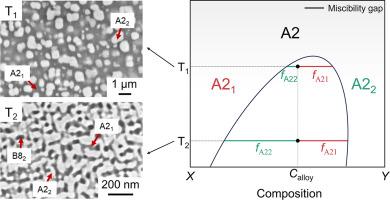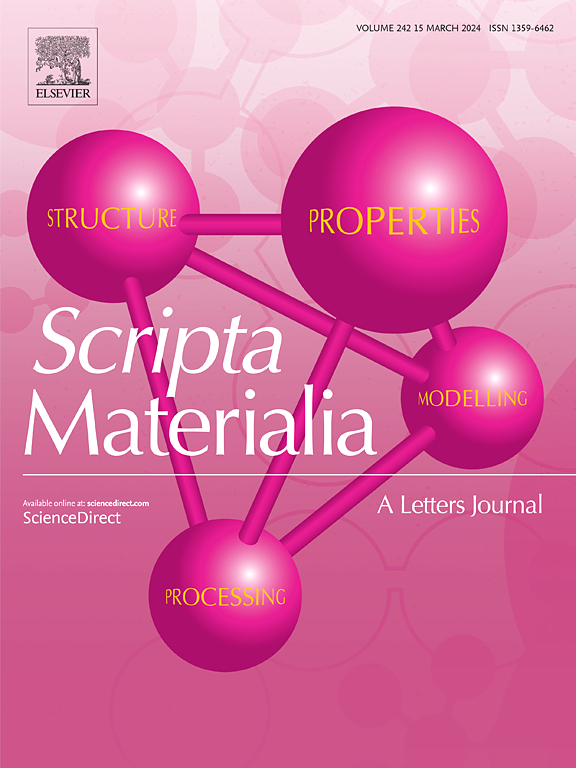A new phase inversion mechanism in refractory high-entropy superalloys: Volumetric phase inversion driven by an asymmetric miscibility gap
IF 5.6
2区 材料科学
Q2 MATERIALS SCIENCE, MULTIDISCIPLINARY
引用次数: 0
Abstract
Refractory high-entropy superalloys (RHESAs) often exhibit an inverted microstructure—an ordered B2 matrix with disordered A2 precipitates—which limits their applicability. While topological phase inversion has been reported in RHESAs, we identify a distinct mechanism, termed volumetric phase inversion (VPI), that reverses the matrix and precipitate phases purely through temperature change. This inversion, observed in a model RHESA, is driven by a strongly asymmetric miscibility gap (MG). The asymmetry arises from unequal shifts in their Gibbs free-energy minima with temperature, primarily due to distinct Al partitioning and differing thermodynamic responses. The mechanism is validated using subregular solution modeling in two ternary proxy subsystems, both reproducing asymmetric MG behavior and confirming the enthalpy–entropy interplay. To our knowledge, this is the first report of a temperature-driven reversal of phase volume fractions in a metallic system. These findings establish VPI as a new thermodynamic pathway for microstructural control in RHESAs and beyond.

一种新的难熔高熵高温合金相转变机制:不对称混相间隙驱动的体积相转变
难熔高熵高温合金(RHESAs)通常表现出倒置的微观结构——有序的B2基体和无序的A2析出物——这限制了它们的适用性。虽然在RHESAs中已经报道了拓扑相反转,但我们确定了一种独特的机制,称为体积相反转(VPI),它完全通过温度变化来逆转基体和析出相。在RHESA模型中观察到的这种反转是由强不对称混相间隙(MG)驱动的。这种不对称是由于它们的吉布斯自由能最小值随温度变化的不相等,主要是由于不同的Al分配和不同的热力学响应。在两个三元代理子系统中使用亚规则解建模验证了该机制,这两个子系统都再现了不对称MG行为并确认了焓熵相互作用。据我们所知,这是金属体系中温度驱动的相体积分数反转的第一个报告。这些发现确立了VPI作为RHESAs及其他微观结构控制的新热力学途径。
本文章由计算机程序翻译,如有差异,请以英文原文为准。
求助全文
约1分钟内获得全文
求助全文
来源期刊

Scripta Materialia
工程技术-材料科学:综合
CiteScore
11.40
自引率
5.00%
发文量
581
审稿时长
34 days
期刊介绍:
Scripta Materialia is a LETTERS journal of Acta Materialia, providing a forum for the rapid publication of short communications on the relationship between the structure and the properties of inorganic materials. The emphasis is on originality rather than incremental research. Short reports on the development of materials with novel or substantially improved properties are also welcomed. Emphasis is on either the functional or mechanical behavior of metals, ceramics and semiconductors at all length scales.
 求助内容:
求助内容: 应助结果提醒方式:
应助结果提醒方式:


